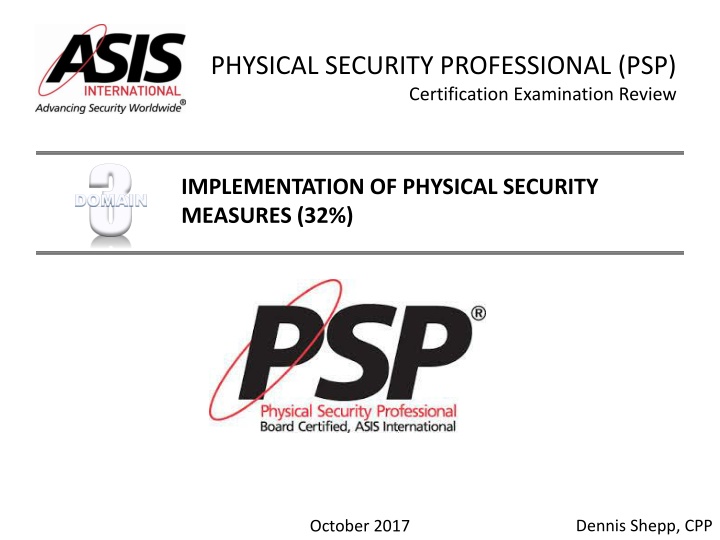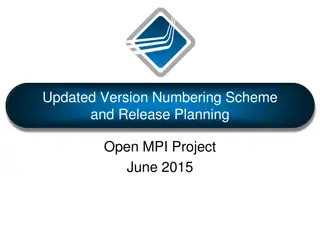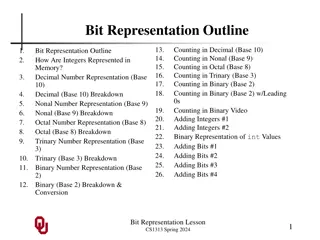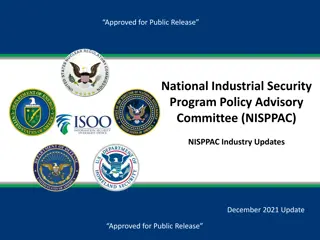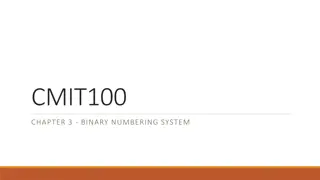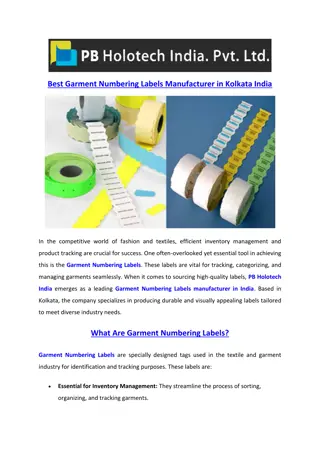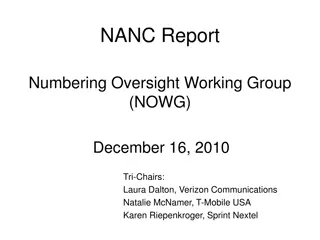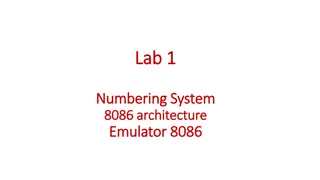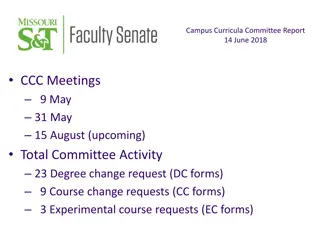Industry Numbering Committee (INC) Report to the NANC
The Industry Numbering Committee (INC) provides a forum to address and resolve industry-wide issues related to North American Numbering Plan resources. This report covers meetings, Issue 788 on 555 Line Number Assignments, and other pertinent topics.
Download Presentation

Please find below an Image/Link to download the presentation.
The content on the website is provided AS IS for your information and personal use only. It may not be sold, licensed, or shared on other websites without obtaining consent from the author.If you encounter any issues during the download, it is possible that the publisher has removed the file from their server.
You are allowed to download the files provided on this website for personal or commercial use, subject to the condition that they are used lawfully. All files are the property of their respective owners.
The content on the website is provided AS IS for your information and personal use only. It may not be sold, licensed, or shared on other websites without obtaining consent from the author.
E N D
Presentation Transcript
PHYSICAL SECURITY PROFESSIONAL (PSP) Certification Examination Review 3 3 IMPLEMENTATION OF PHYSICAL SECURITY MEASURES (32%) DOMAIN DOMAIN Dennis Shepp, CPP October 2017
ASIS International Certification Exam Review (DOMAINS) SUBJECTS DOMAIN 3: IMPLEMENTATION OF PHYSICAL SECURITY MEASURES (32%) Physical Security Assessment DOMAIN 1 - Physical Security Assessment (34%) Physical Security ACCESS CONTROL SYSTEMS Assessment ACCESS CONTROL DOMAIN 2 Application, Design and Integration of SYSTEMS Application, Design and Integration of Physical Physical Security Systems (34%) Security Systems DOMAIN 3 Implementation of Physical Implementation of Physical Security Security Measures (32%) Measures October 2017 Dennis Shepp, CPP
ASIS International Certification Exam Review DOMAIN 3: IMPLEMENTATION OF PHYSICAL SECURITY MEASURES (32%) Task 1: Outline criteria for pre-bid meeting to ensure comprehensiveness and appropriateness of implementation Task 2: Procure system to address risks identified Task 3: Conduct final acceptance testing and implement/provide procedures for ongoing monitoring and evaluation of the measures Task 4: Implement procedures for ongoing monitoring and evaluation throughout the system life cycle Task 5: Develop requirements for personnel involved in support of the security program October 2017 Dennis Shepp, CPP
ASIS International Certification Exam Review DOMAIN 3: IMPLEMENTATION OF PHYSICAL SECURITY MEASURES (32%) Task 1: Outline criteria for pre-bid meeting to ensure comprehensiveness and appropriateness of implementation October 2017 Dennis Shepp, CPP
ASIS International Certification Exam Review DOMAIN 3: IMPLEMENTATION OF PHYSICAL SECURITY MEASURES (32%) Task 1: Outline criteria for pre-bid meeting to ensure comprehensiveness and appropriateness of implementation. Knowledge of: 1. Bi d package components 2. Criteria for evaluation of bids 3. Technical compliance criteria 4. Ethics in contracting October 2017 Dennis Shepp, CPP
3.1.1: The bid package components for pre-bid meeting to ensure comprehensiveness implementation and appropriateness of CHAPTER 13 PRINCIPLES OF PROJECT MANAGEMENT, Knoke Physical Security Principles (Kindle Locations 10546- 10548) Combining the design package into a bid package (including manufacturer s contract information, drawings, specifications, hardware schedules, bidder instructions and requirements, licenses, experience, and qualifications; terms and conditions; and security- sensitive information requirements)
CHAPTER 6 PROCUREMENT Patterson, David G.. Implementing Physical Protection Systems: A Practical Guide, 2nd Edition (Kindle Locations 1726-1729) Invitation for bids (IFB) - used when the customer has completed its own security system design, including the selection of hardware and software. The invitation for bids asks vendors to state the cost of materials and installation. Usually, the qualified bidder with the lowest price is awarded the contract. This type of procurement is also referred to as a request of quotation (RFQ). Bid package or construction documents consists of bidders instructions, specifications, drawings and schedules, and hardware schedules.
3.1.2 and 3.1.4: Outline the criteria for the evaluation of bids and explain the ethics in contracting relating to the pre-bid meeting to ensure comprehensiveness and appropriateness of implementation. CHAPTER 6 PROCUREMENT Evaluation Criteria , Forms a basis for ethical guidelines and metrics for the procurement and selection process. No direct reference to ethics in the pre-bid, bid or entire procurement process. Recommend follow standards and best practice as outlined in the Procurement Process (14.8 Knoke) and Patterson be guided accordingly by the processes discussed.
3.1.3: Outline the technical compliance criteria for pre-bid meeting to ensure comprehensiveness and appropriateness of implementation CHAPTER 5: Patterson, page 80: Bid bond - guarantees that the bidder on a contract will enter into the contract and furnish the required payment and performance bonds. Common business practice for the tender to be supported by a bid bond (also known as a tender bond). An indication of the contractor s ability to carry out the work requested. Form of insurance should the successful bidder fail to proceed with the contract for any reason.
Performance bond - Most large projects put out to bid require the successful bidder to provide a performance bond after being awarded the contract. Indicates that the company has the necessary skills and capabilities to carry out the required work and comply with the agreed terms and conditions of the contract. 14.3.5 SPECIFICATIONS Knoke page 458 PPS specification includes: instructions to bidders with a list of all documents included in the contract documents list of project references
functional description of the complete system design, its intended functional operation in a concept of operations, maintenance and warranty requirements, quality assurance provisions, and installation schedule list of design drawings list and description of products and services to be included in the contract list of required products and services included in other contracts (such as electrical door hardware, which is provided and installed under the door hardware contract but must be connected to the PPS by the security contractor)
list of applicable codes and standards support services, such as drawing, sample and documentation submittals, commissioning, testing, training, warranty, maintenance, and spare parts technical descriptions of all major subsystems and their components, including capacity, capability, expandability, performance and operational parameters, environmental operating parameters, installation and integration details, appearance and finish, and acceptable makes and models general site conditions, installation standards, exact statement of particulars, materials, dimensions, and quality control standards
ASIS International Certification Exam Review DOMAIN 3: IMPLEMENTATION OF PHYSICAL SECURITY MEASURES (32%) Task 2: Procure system to address risks identified October 2017 Dennis Shepp, CPP
ASIS International Certification Exam Review DOMAIN 3: IMPLEMENTATION OF PHYSICAL SECURITY MEASURES (32%) Task 2: Procure system to address risks identified. Knowledge of: 1. Project management functions and processes throughout the system life cycle. 2. Vendor pre-qualification (interviews and due diligence). 3. Procurement process. 7. End user training requirements October 2017 Dennis Shepp, CPP
Procuring systems to address risks identified and describe project management functions and processes throughout the system life cycle. CHAPTER 2 OVERVIEW OF LIFE CYCLE PHASES, Patterson, David G.. Implementing Physical Protection Systems: A Practical Guide, 2nd Edition (Kindle Locations 449) Stage 1: Project Feasibility. Stage 2: Project Development Stage 3: Project Execution Stage 4: Project Closeout
Describe Installation and inspection techniques regarding integrations. CHAPTER 6 SELECTING CONTRACTORS, Patterson Bidder Qualifications (examples provided) CHAPTER 8: COMMISSIONING AND WARRANTY, Patterson, David G.. Implementing Physical Protection Systems: A Practical Guide, 2nd Edition (Kindle Locations 2757-2760). Commissioning is the process of ensuring that all systems and components are designed, installed, tested, and operated according to the operational requirements of the owner. An all-inclusive process for all the planning, design, assembly, delivery, installation, and verification of a PPS.
Commissioning should formalize the review and integration of all project expectations, during all the PPS phases, through inspection, functional performance testing, oversight of operator training, and detailed documentation. Goals of commissioning are as follows: o Define and document requirements clearly at the outset of each phase and update through the process. o Verify and document compliance at the completion of each phase. o Establish and document commissioning tasks for subsequent-phase team members.
o Deliver PPSs that meet the customers needs at the time of completion. o Verify that alarm assessment and response procedures are completed. o Verify that operation and maintenance personnel are properly trained. o Verify PPS performance across its life cycle. Key activities are as follows: o Establish goals for quality, efficiency, and functionality. o Establish a commissioning approach and scope. o Establish a commissioning budget. o Establish commissioning plans. o Establish commissioning schedules. o Develop commissioning specifications.
o Determine special testing needs. o Establish re-commissioning plans. o Document compliance and acceptance. The commissioning plan sets out how the organization wants the new system to be installed and commissioned.
Describe methods and process for commissioning and installation problem resolution (punchlists). CHAPTER 2: PPS Life Cycle Phase 4: Installation, Operation, and Training, Patterson, David G.. Implementing Physical Protection Systems: A Practical Guide, 2nd Edition Punch list is a contract document used in the architecture and building trades to organize the completion of a construction project. Commissioning is the process of ensuring that all systems and components of a system are designed, installed, tested, operated, and maintained according to the operational requirements of the owner..
PPS Life Cycle Phase 5: Commissioning and Warranty The tests performed by the implementation team may involve equipment, personnel, procedures, or any combination. Tests should simulate realistic conditions and provide conclusive evidence about the effectiveness of the security system. While a system is still under warranty, usually for one year, the installation contractor is expected to maintain the system free of charge. Figure 2-5 shows key steps in the commissioning and warranty phase.
Describe the systems configuration management and final acceptance testing criteria. 15.4.2 SITE ACCEPTANCE TESTING, Knoke. Physical Security Principles (Kindle Locations 11995-11996) PAGE 507 For the security system acceptance tests, the following should be done: verification that the data and video transmission system and any signal or control cabling have been installed, tested, and approved as specified when the system includes remote control/ monitoring stations or remote switch panels, verification that the remote devices are functional, communicate with the security monitoring center, and perform all functions as specified
verification that the video switcher is fully functional and that the switcher software has been programmed as needed for the site configuration verification that all system software functions work correctly operation of all electrical and mechanical controls and verification that the controls perform the designed functions verification that all video sources and video outputs provide a full-bandwidth signal verification that all input signals are terminated properly verification that all cameras are aimed and focused properly
verification that cameras facing the rising or setting sun are aimed sufficiently below the horizon that they do not view the sun directly if vehicles are used near the assessment areas, verification of night assessment capabilities (including whether headlights cause blooming [loss of detail due to excessive bright spot] or picture degradation) verification that all cameras are synchronized and that the picture does not roll when cameras are switched verification that the alarm interface to the intrusion detection subsystem is functional and that automatic camera call-up is functional for all designated alarm points and cameras
when pan/ tilt mounts are used in the system, verification that the limit stops have been set correctly, that all controls for pan/ tilt or zoom mechanisms are operative, and that the controls perform the desired function if pre-position controls are used, verification that all home positions have been set correctly and have been tested for auto home function and correct home position
Procuring systems to address risks identified and describe vendor pre-qualification (interviews and due diligence). ASIS International Certification Exam Review DOMAIN 3: IMPLEMENTATION OF PHYSICAL SECURITY MEASURES (32%) CHAPTER 6 PROCUREMENT - SELECTING CONTRACTORS , Patterson, Implementing Physical Protection Systems: A Practical Guide, 2nd Edition (Kindle Locations 1833-1835). Requires the same amount of effort as hiring a new employee. Qualifications must be reviewed, references checked, and interviews held with the people who will perform the work. Ensure that the personnel identified in proposals are the ones who will actually perform the work. October 2017 Dennis Shepp, CPP
Ask for written employee guarantees from the contractor. Once three or four qualified contractors have been identified, the proposal can be sent to them alone. Be prepared to defend its selection of qualified contractors by using written selection criteria and documenting the results. Reduce selection down to two or three vendors. The project team interviews these contractors and asks about their experiences on other projects and how they plan to approach this project. Interviews provide valuable insight into contractors understanding of the project and objectives, compatibility with company culture and personnel, and ability to complete the project successfully.
Describe The procurement process. 14.8.2 PROCUREMENT PROCESS, Michael E. Knoke. Physical Security Principles (Kindle Locations 11573- 11574) pages 489
Facilities Physical Security Guidelines for information describing implementation of physical security measures and end user training requirements. 3.6.6 Maintenance Camera maintenance must be considered before system implementation. 3.2.1.3.2 Turnstiles In deploying circular turnstiles, it is important to remember that turnstiles added to a fence, it may provide a means for an intruder to climb over and enter the area. 3.7.2.1 Organization Proprietary security offers more control over hiring, supervision and training. 3.7.2.4 Training Security officers should be trained and tested on the following:
Officers who handle weapons require extensive and ongoing training.
Implementing Physical Security Systems, (Patterson) for information describing implementation of physical security measures and end user training requirements. CHAPTER 1: PHYSICAL PROTECTION SYSTEMS, Patterson, David G.. Implementing Physical Protection Systems: A Practical Guide, 2nd Edition (Kindle Locations 187-190) Physical protection systems are systems that combine equipment, people, and procedures to protect assets against theft, destruction, sabotage, and other malevolent human acts. A PPS may consist of a guard force, obstacles (like fences and locked doors), and electronic components (such as access control systems, intrusion detection systems, and closed-circuit television (CCTV) systems).
Physical Security Principles (ASIS International) for information describing implementation of physical security measures and end user training requirements. 15.5 TRAINING, 15.5.1 GENERAL TRAINING REQUIREMENTS, Knoke. Physical Security Principles (Kindle Locations 12102-12105) pages 511-512 Well-conceived, well-executed security training programs, personnel can be better prepared to prevent incidents from happening, respond properly to incidents that do arise, and contribute to recovery efforts more effectively. Without appropriate training, personnel are more likely to contribute to security risks accidentally.
15.5.2 TRAINING TOPICS System administration System monitoring Alarm system & dispatch Incident response System maintenance & troubleshooting IT function System overview
Task 4.1. Implement procedures for ongoing monitoring and evaluation throughout the system life cycle describing maintenance inspection techniques. CHAPTER 16.1 MAINTENANCE, PAGES 516-523, Knoke. Physical Security Principles (Kindle Locations 12209- 12210) Pages 516 - 523 Remedial Maintenance - This corrects faults and returns the system to operation in the event that a hardware or software component fails. Preventive Maintenance - This consists of scheduled maintenance to keep the hardware and software in good operating condition.
CHAPTER 9: MAINTENANCE, EVALUATION & REPLACEMENT, Pages 178, 180, 191 Patterson, Remedial Maintenance Preventive Maintenance
ASIS International Certification Exam Review DOMAIN 3: IMPLEMENTATION OF PHYSICAL SECURITY MEASURES (32%) TASK 4: Implement procedures for ongoing monitoring and evaluation throughout the system life cycle. October 2017 Dennis Shepp, CPP
ASIS International Certification Exam Review DOMAIN 3: IMPLEMENTATION OF PHYSICAL SECURITY MEASURES (32%) TASK 4: Implement procedures for ongoing monitoring and evaluation throughout the system life cycle. Knowledge of: 1. Maintenance inspection techniques 2. Test and acceptance criteria 3. Warranty types 4. Ongoing maintenance, inspections, and upgrades 5. Ongoing training requirements 6. Systems disposal and replacement processes October 2017 Dennis Shepp, CPP
ASIS International Certification Exam Review DOMAIN 3: IMPLEMENTATION OF PHYSICAL SECURITY MEASURES (32%) TASK 5: Develop requirements for personnel involved in the support of the security program. October 2017 Dennis Shepp, CPP
ASIS International Certification Exam Review DOMAIN 3: IMPLEMENTATION OF PHYSICAL SECURITY MEASURES (32%) TASK 5: Develop requirements for personnel involved in the support of the security program. Knowledge of: 1. Roles, responsibilities and limitations of security personnel (including proprietary (in-house) and contract security staff) 2. Human resource management 3. Security personnel training, development and certification 4. General, post and special orders 5. Security personnel uniforms and equipment 6. Personnel performance review and improvement processes 7. Methods to provide security awareness training and education for non-security personnel October 2017 Dennis Shepp, CPP
ASIS International Certification Exam Review DOMAIN 3: IMPLEMENTATION OF PHYSICAL SECURITY MEASURES (32%) ALL groups have 30 minutes to complete the research and complete the report. Report in PowerPoint or using flipcharts All presentations must identify the name of the resource, chapter number and page location of the information EXAMPLE: (ASIS Int l Facilities Physical Security Measures Guideline, Chap. 3.4.1 Security Lighting Applications, Page 23 25) October 2017 Dennis Shepp, CPP
Task 4.2 & 4.3. Implement procedures for ongoing monitoring and evaluation throughout the system life cycle describing test and acceptance criteria as well as the warranty types. CHAPTER 8: PPS TESTING, Patterson, Implementing Physical Protection Systems: A Practical Guide, 2nd Edition (Kindle Locations 2809-2810), page 164 Ideal testing stresses the established limits site- specific threats. Simulate actual threat conditions and provide conclusive evidence that the security system will counter each threat scenario.
CHAPTER 2: OUTPUTS OR DELIVERABLES, Commissioning and Warranty Phase , Patterson, Implementing Physical Protection Systems: A Practical Guide, 2nd Edition (Kindle Locations 590-597), page 170 Factory acceptance test plan Site acceptance test plan Pre-delivery or factory acceptance test data Site acceptance test data Factory acceptance tests punch list Site acceptance tests punch list Reliability or availability test data and punch list After-acceptance test data Warranty plan Warranty reports
CHAPTER 2: OUTPUTS OR DELIVERABLES, Commissioning and Warranty Phase , Patterson, Implementing Physical Protection Systems: A Practical Guide, 2nd Edition (Kindle Locations 590-597), page 170 Warranty records Upgrades
Task 4.4 & 4.5. Implement procedures for ongoing monitoring and evaluation throughout the system life cycle describing ongoing maintenance, inspections, upgrades and training requirements. CHAPTER 2: OVERVIEW OF LIFE CYCLE PHASES, Patterson, page 25-28 A physical protection system (PPS) has a life cycle that includes six phases: 1. Planning 2. Design and estimation 3. Procurement 4. Installation, operation, and training 5. Testing and warranty 6. Maintenance, evaluation, and replacement
Task 4.6: Implement procedures for ongoing monitoring and evaluation throughout the system life cycle describing systems disposal and replacement processes. CHAPTER 2: PPS Life Cycle Phase 6: Maintenance, Evaluation, and Replacement , page 191 Patterson, David G.. Implementing Physical Protection Systems: A Practical Guide, 2nd Edition (Kindle Locations 547-551). Warranty completed organization must assume maintenance of the PPS. Sometimes an organization will train its own personnel to maintain the PPS. Other times, the organization will have the supplying contractor continue to perform maintenance. Option is to solicit bids for the maintenance work.
When system completes its useful life the process of replacement will begin. To justify the replacement cost, factors such as the cost of maintenance, lack of spare parts, obsoleteness of hardware and software, operating costs, unreliability, and other negative aspects should be considered. Replacement may also be justified by new technologies and features that provide improved security, the ability to reduce manpower, or other benefits.
